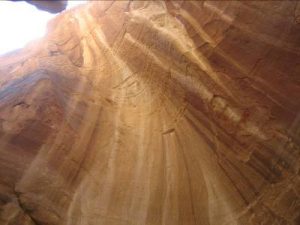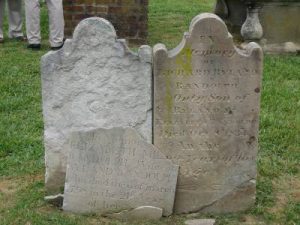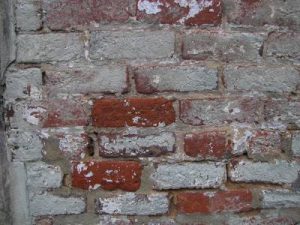 Virginia Department of Historic Resources
Virginia Department of Historic Resources Virginia Department of Historic Resources
Virginia Department of Historic ResourcesThis page is currently under construction. Check back for new and improved content.
Abrasion: a surface loss caused by excess friction such as rubbing or handling
Bedding planes: surface separating successive layers of stratified rock; associated with sandstone and other sedimentary rocks

Biological degradation: surface degradation caused by fungal, lichen or other organisms, which produce enzymes that dissolve, stain, or degrade the host material provided sufficient humidity
Corrosion: degradation of metals from a chemical or electrolytic reaction; rust (iron corrosion), copper alloy corrosion (includes copper, bronze, and brass), and zinc corrosion are the types of corrosion most frequently associated with cemeteries
Cracks: narrow fissures or fractures in stone or metal; hairline cracks do not exhibit significant space between the fissure or fracture, while widened cracks have significant space between both sides of the fissure/fracture

Delamination: stone damage resulting from stone breaks or separations along bedding planes usually resulting in breakage; may be the result of frost damage, exposure to fire, etc.
Discolored/stained: stone discoloration caused by vegetation, fungus, pollution or chemical reaction; staining and any information regarding its cause should be noted; different stains require different approaches to cleaning
Disfigurement: a change that defaces, modifies, or blemishes the original appearance and intention of the maker; they may be intentional (vandalism, restoration in a different style) or accidental (stains, lawn mower scars)
Displaced: a stone/artifact that has been moved from its original location

Efflorescence: deposits of white or gray salts on stone surface that can be caused by many things including (1) fertilizers and weed-killers, (2) air or water pollution, (3) use of gray Portland cement in concrete and mortars, and (4) some cleaning compounds (5) rising damp
Erosion: a gradual wearing away of stone surface resulting in rounded, blurred edges, and damage to carved details; caused by natural abrasion due to wind and wind blown particles, and by dissolution of the surface by acidic rainfall
Fragments: small pieces; can be associated with a stone/artifact that is still standing, or, may represent the remains of the original stone/artifact, which has disintegrated
Freeze-Thaw: cycle of repeated temperature changes that result in the freezing and thawing of water that has penetrated materials; results in surface and structural damage
Friable: easily breakable; crumbles
Grain size: refers to visible particles seen in stone surface

Grime: surface dirt that may be a combination of air-borne soot, nicotine, candle grease, etc.
Grout: material used to fill cracks and crevices in masonry and stones
Gypsum Crust: black crust that, when removed, exposes the softer stone beneath; caused by sulfur containing pollutants in the air; common to marble and limestone
In Situ: a stone/artifact in its original location
Mower Scars: abrasions/scratches caused by grass cutting equipment, usually near the bottom of the stone
Porous: a material that contains many small, interconnected holes (pores) that allow water, air, or other materials to pass through them (permeate); permeable
Relative Humidity (RH): amount of water air can hold at a specific temperature; RH expresses the relationship between moisture in the air to the maximum amount of moisture that could be present in the air at a given temperature and is expressed as a percentage; relative humidity effects biological growth and corrosion processes
Rising Damp: a form of dampness that occurs in stone, brick, and masonry, when groundwater rises up through these materials via capillary action, which is the ability of a liquid to flow in narrow spaces in opposition to gravity. This can generally cause issues up to three feet high.
Soluble Salts: Salts from the ground that dissolve in ground water. They are deposited in stone, brick, and masonry as the water from rising damp evaporates. These deposits crystallize and deteriorate grave markers.
Sound: condition of a marker that shows no sign of damage, no improper previous repairs and no excessive deterioration (based on reasonable inspection)
Spalling/Scaling: loss of flakes or fragments from surface due to frost, pressure and other mechanisms

Structural damage: damage, losses, etc. that cause degeneration of the overall structure
Sugaring: granular, sometimes powdery, stone surface that is characteristic of particularly fine-grained marbles and limestone; sugaring indicates gradual surface disintegration
Surface accretion: accumulation of extraneous matter on stone marker surface that alters original design, i.e. dirt, dust, grime, etc.
Surface damage: damage, losses, staining limited to the marker surface
a stone that is no longer fully upright, but has not yet fallen; the extent to which a stone is tilted or sunken will determine the priority given for resetting
Granite
Granite is an igneous rock composed chiefly of quartz with coarse-grains that can take a high polish. Granite is one of the most common rocks found in continental crusts and is formed by slow, underground cooling of magma. Granite color depends on mineral content and may vary to include light pink and grey to red, brown and black. Granite is highly durable and often used for architectural and artistic purposes. Granite is relatively acid resistant. Most granite materials exhibit minimal weathering; however, some examples may lose surface polish over time.
Limestone
Limestone is a sedimentary rock composed principally of calcium carbonate (calcite) or dolomite (magnesium carbonate mineral). Limestone varies greatly in texture and porosity. Dolomitic limestones often include fossils. It is usually white, gray, or buff in color. Limestone, unlike marble, does not take a polish well and items made of limestone will exhibit a more matte appearance. Under normal conditions, limestone weathers to a light silver gray or white depending on the stone variety, but is usually darker in color than the bright white associated with marble. Pollution and acid rain may cause significant deterioration. Breaks and cracking often occur along the bedding planes.
Sandstone
Sandstone is a sedimentary rock that forms from sand-sized quartz particles held together by natural mineral cements. Sandstones generally have visible bedding planes that reflect the stone’s formation process. Sandstones are porous, soft and easily worked. Over time, sandstones may lose individual grains and rising damp can cause significant condition problems. Sandstone and limestone deteriorate in similar ways. Rising damp and freeze-thaw cycles can cause spalling or surface delamination of cut or polished faces.
Marble
Marble is a crystalline metamorphic rock composed of calcium carbonate. Marble forms from the alteration of limestone under intense geologic pressure. Marble is generally composed of calcite and aragonite (calcium carbonate minerals), and/or dolomite, which are generally white in color. Marble varies from bright white to colors caused by mineral impurities including pink, red, brown, grey or black. Marble is a soft rock (relative to granite/ that is easily scratched, producing a white powder. Exposure to water and acids produces uneven weathering of individual grains. Common condition problems include dissolution by acid rain and sugaring. Marble will convert to gypsum when exposed to pollution containing sulfuric acid (i.e. acid rain). This can produce a black crust that will ultimately blister and crumble away from the stone surface. Marble is also prone to sugaring, a gradual disintegration of the surface, causing a rough granular, crystalline or powdery appearance.
Slate
Slate is a homogeneous, foliated metamorphic rock that is fine-grained. Slate is derived from an original shale-type sedimentary rock composed of clay or volcanic ash through metamorphism. Slate is generally grey in color and can be split along stone cleavage and grain. The stone has extremely low water absorption and is resistant to frost damage and breakage due to freezing. Slate is used for grave markers where the stone is available.
Concrete
Concrete is a building material composed of calcined limestone or Portland cement, clay, sand and/or gravel, and water. Concrete can be molded in a wide variety of shapes and surface textures and funerary markers cast from concrete were often finished to resemble limestone. Hardness and strength depend on the proportions of cement, sand, and aggregate (gravel or stone) mixed with water. Concrete is gray or white unless artificially colored. Concrete is porous and is susceptible to damage from rising damp and freeze-thaw cycles, as well as extreme heat. Concrete deterioration includes cracking, spalling and delamination. When concrete is reinforced with iron or steel rebar, water exposure can result in rusting, corrosion and cracking.
Brick
Brick is a block of fired ceramic material used in masonry construction and usually laid using mortar. Bricks are very porous and are susceptible to damage due to freeze-thaw cycles, as well as salts efflorescence.
Mortar
Mortar is a mixture of lime or cement or a combination of both with sand and water, used as a bonding agent between bricks, stones, and other masonry
Iron
Iron is a magnetic and ductile metal element that occurs abundantly. Iron metals range in color, depending on the presence of oxygen and the method of manufacture. Iron materials are easily identified using a magnet. Some historic cemeteries incorporate iron monuments, crosses, fences or other decorative elements. Small iron medallions placed beside markers may indicate the deceased’s affiliation with fraternal or military associations. Typical iron corrosion produces powdery orange or red surface deterioration products (rust). Iron corrosion is powdery and substantially decreases the metal’s overall strength.
Copper and its Alloys
Copper is a ductile and malleable, non-magnetic, reddish-brown metal. Bronze is an alloy consisting chiefly of copper and tin. Brass is an alloy consisting of mainly copper and zinc. Copper and its alloys were used, and continue to be used, to produce medallions in cemeteries, as well as to make repairs. Copper and bronze will corrode when exposed to high relative humidity and soluble salts. The resulting powdery, light green corrosion substantially decreases the overall stability and strength of the metal and may cause staining of surrounding materials.
Zinc (white bronze)
Zinc (white bronze) is a bluish-gray nonmagnetic, metallic element that is generally brittle. When heated, zinc may be worked. Zinc has a high resistance to atmospheric corrosion. Often zinc was used to produce tall, commemorative monuments, though smaller markers such as tablets and ground markers were also available. The monuments are hollow and retain much of their original definition. Corrosion is a potential problem for any metal monument, especially in highly polluted or seaside atmospheres. Zinc monuments survive remarkably well. For statues of the type that were originally painted, corrosion can be limited by regular painting. Some zinc monuments manufactured with copper-plating will exhibit extreme surface pitting due to corrosion.
8.01-44.6
Action for injury to cemetery property – allows a cemetery owner/operator to recover damages sustained due to willful or malicious destruction, mutilation, defacement or removal of any cemetery element.
10.1-2305
Permit required for the archaeological excavation of human remains – legal procedure for obtaining a permit from the Department of Historic Resource to allow professional archaeological recovery and physical analysis of buried human remains.
15.2-2258
Plat of proposed subdivision and site plans to be submitted for approval – anyone wishing to subdivide property in any area where subdivision ordinances apply must include the location of any human graves or cemeteries within that property on any plat submitted for local review.
18.2-125
Trespass at night upon any cemetery – prohibits entrance to any cemetery, its grounds, or parking/driving areas at night for any purpose other than to visit the gravesite of a family member. Class 4 misdemeanor (up to $250 fine).
18.2-126
Violation of sepulture; defilement of dead human body – prohibits unlawful removal of all or part of a buried human body. Class 4 felony (2-10 years in prison, up to $100,000 fine). Also prohibits willful and intentional defilement (defined as “unlawful purpose”) of a dead human body. Class 6 felony (1 to 5 years in prison, up to $2500 fine).
18.2.127
Injuries to churches, church property, cemeteries, burial grounds, etc. – prohibits unauthorized damage to or destruction of plants, trees, funerary offerings, etc. Class 1 misdemeanor (up to 1 year in prison, up to $2500 fine). Also prohibits willful damage to or destruction of tombs, monuments, church buildings, fences, walls, etc. Class 6 felony.
32.1-303
Penalty for trafficking in bodies. – Prohibits the unlawful sale or purchase of, or transmission for the unlawful sale or purchase of, a dead human body. Class 1 misdemeanor.
33.1-241
Roads not to be established through a cemetery or seminary of learning without owners’ consent – prohibits construction of roads through any cemetery property without landowner permission.
45.1-252
Designating areas unsuitable for coal surface mining – coal surface mining cannot be conducted within 100 feet of a cemetery.
57-27.1
Access to cemeteries located on private property; cause of action for injunctive relief – mandates access to cemeteries on private land for visitation, maintenance and genealogical purposes, with reasonable notice to landowner. Visitor assumes all liability.
57-36
Abandoned cemeteries may be condemned; removal of bodies – local governments may condemn abandoned or neglected cemeteries through eminent domain and in order to use the land for other purposes.
57-38.1
Proceedings by landowner for removal of remains from abandoned family graveyard – landowners may petition the county or city circuit court for permission to remove and relocate human burials located in cemeteries in which there have been no burials for at least 25 years and upon which there are no reservations of rights.
57-38.2
Proceedings by heir at law or descendant for removal of ancestor’s remains from abandoned family cemetery – heir or descendant may petition the county or city circuit court for permission to remove and relocate an ancestor’s remains from a cemetery in which there have been no burials for at least 25 years.
57-39
Proceedings for removal of remains and sale of land vacated – owners or trustees of neglected or disuses cemeteries and potter’s fields may petition the county or city circuit court for permission to relocate the remains and sell the property. In the case of a potter’s field, the court may mandate that the proceeds be used for charitable purposes.
57-39.1
Improvement of abandoned and neglected graveyards – owners of land adjacent to abandoned or neglected cemeteries may petition the court for permission to return the cemetery to a suitable condition.
Cemetery Interment Records – Library of Virginia
Public/Private Cemeteries – Guide organized by county/city.
For Example – Blandford Cemetery (LVA Accession 41780), Hollywood Cemetery (LVA Accession 30045), Oakwood Cemetery (LVA Accession 31702c)
Church/Family Cemetery Records – Manuscripts organized by county/city.
Lists of Burials, Tombstone Inscriptions, Miscellaneous Cemetery Records Collection (MCRC)
Related Records
Vital Records – Death Certificates 1912-1939, (LVA Accession 36390)
Other Records – Billups Funeral Home, 1880-1983. (LVA Accession 42969)
Personal Collections – Raymond W. Watkins. Collection, 1861–1995. (LVA Accession 32384)
Newspapers – obituaries
Published Sources
Hogg, Anne M. and Dennis A. Tosh. eds. Virginia Cemeteries: A Guide to Resources. Charlottesville, Va.: University of Virginia Press, 1986.
Roll of honor: names of soldiers who died in defense of the American Union, interred in the national cemeteries. Baltimore, Md.: Genealogical Pub. Co., 1994.
Spratt, Thomas M. Men in Gray Interments. Athens, Ga.: Iberian Publishing, 1996–.
Magazine of Virginia Genealogy, National Genealogical Society Quarterly, Virginia Genealogist, Virginia Magazine of History and Biography, William and Mary Quarterly
Websites
Dept. of Veterans Affairs, National Gravesite Locator
National Park Service Civil War Site
The Tombstone Transcription Project
Carmack, Sharon DeBartolo, ed. Your Guide to Cemetery Research. Cincinnati: Betterway Books, 2002.
Cavender, Anthony, ed. “A Folk Medical Lexicon of South Central Appalachia,” Miscellaneous Paper No. 1, History of Medicine Society of Appalachia. Johnson City: East Tennessee State University, 1990.
Davis, Veronica A. Here I Lay My Burdens Down: A History of the Black Cemeteries of Richmond, Virginia. Richmond, VA: Dietz Press, 2003.
Deetz, James. “Chapter 4: Remember Me as You Pass By,” In Small Things Forgotten: An Archaeology of Early American Life. 2nd ed. New York: Anchor Books, 1996.
Hacker, Debi. Iconography of Death: Common Symbolism of Late 18th Through Early 20th Century Tombstones in the Southeastern United States. Columbia, SC: Chicora Foundation, 2001.
Helsley, Alexia Jones. Silent Cities: Cemeteries and Classrooms. Columbia, SC: South Carolina Department of Archives and History, 1997.
Keister, Douglas. Stories in Stone: A Field Guide to Cemetery Symbolism and Iconography. Salt Lake City: Gibbs Smith Publisher, 2004.
King, Gregg G., Susan Kosky, Kathleen Glynn, and Gladys Saborio. Michigan Historic Cemeteries Preservation Guide. Saline, MI: McNaughton and Gunn Inc.
Little, M. Ruth. Sticks and Stones: Three Centuries of North Carolina Gravemarkers. Chapel Hill: University of North Carolina Press, 1998.
London, Mark. Masonry: How to Care for Old and Historic Brick and Stone. Washington, D.C.: National Trust for Historic Preservation, 1988.
McGahee, Susan H. and Mary W. Edmonds. South Carolina’s Cemeteries: A Preservation Handbook. 2nd ed. Columbia, SC: South Carolina Department of Archives and History, 2003. (Available online at http://www.state.sc.us/scdah/hstcm.pdf.)
Nichols, Elaine, ed. The Last Miles of the Way: African-American Homegoing Traditions 1890-Present. Columbia, SC: Dependable Printing Company, Inc., 1989.
Potter, Elizabeth Walton and Beth M. Boland, eds. National Register Bulletin 41: Guidelines for Evaluating and Registering Cemeteries and Burial Grounds. U.S. Department of the Interior National Park Service Interagency Resources Division National Register of Historic Places, 1992. (Available online at http://www.nps.gov/history/nr/publications/bulletins/nrb41/)
Strangstad, Lynette. Preservation of Historic Burial Grounds. Washington, DC: National Trust for Historic Preservation, 2003.
Strangstad, Lynette. A Graveyard Preservation Primer. Walnut Creek, CA: Altamira Press, 1995.
Trinkley, Michael. Grave Matters: The Preservation of African-American Cemeteries. Columbia, SC: Chicora Foundation, 1995.
Virginia genealogical societies and census data:
Virginia regional historical societies: http://www.lva.virginia.gov/public/historical.asp
Virginia Museum of History and Culture (formerly Virginia Historical Society): https://www.virginiahistory.org/
Library of Virginia: http://www.lva.virginia.gov/
Library of Congress: http://www.loc.gov/index.html
National Archives, Genealogy Section: http://www.archives.gov/genealogy/
National Park Service National Center for Preservation Technology and Training – Conservation Information: http://www.ncptt.nps.gov/category/training/cemetery-monument-conservation-materials-research/
Association for Gravestone Studies – Conservation Information: https://www.gravestonestudies.org/preservation
Connecticut Gravestone Network – Conservation Information: http://ctgravestones.org/instructive-articles/
Northern New York Genealogy – Conservation Information: http://www.nnygenealogy.com/pages/preservation-grave-stones.html
Gravestone Preservation and Restoration Information: http://gravestonepreservation.info/
American Institute for Conservation – Find a Conservator http://www.conservation-us.org/membership/find-a-conservator
Updated April 29, 2021